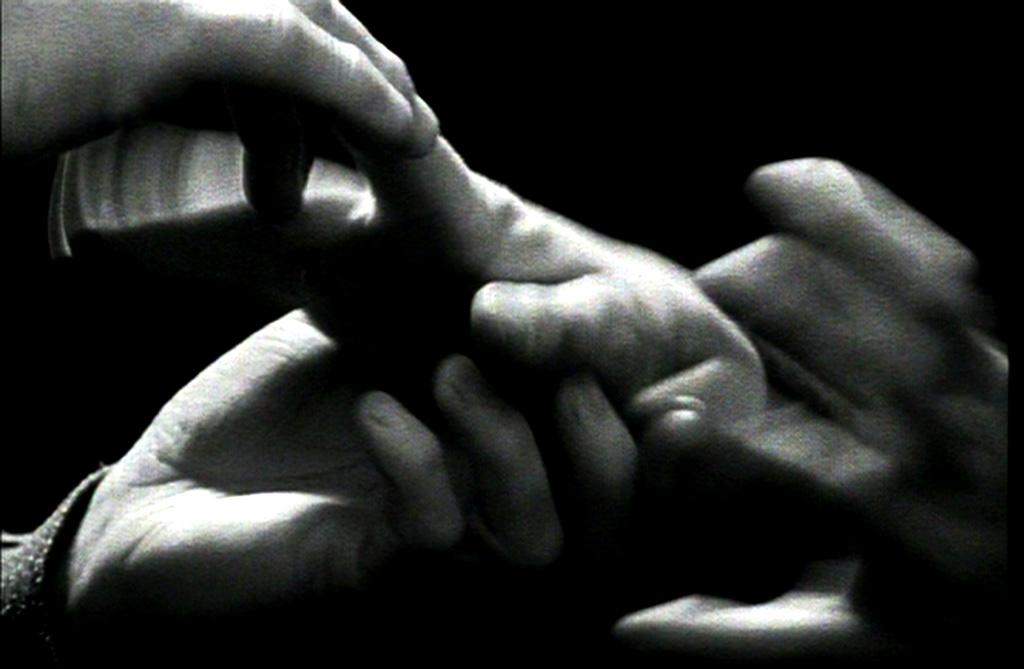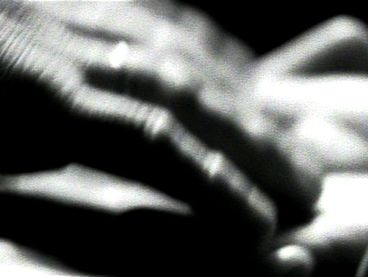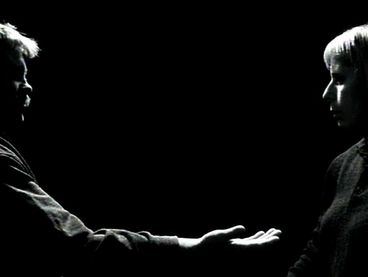MOOZ – audiovisual arts collection
Lormen
2003, 03:45 min., Super 16 mm, b/w
Direction, screenplay, camera, and editing: Julia Daschner
Protagonists: Sabine Pirker und Franz Pirker
Sound: Steffi Niederzoll, Johannes Naber
Advisors: Prof. Michael Graham-Smith, Prof. Dietrich Leder, Andreas Fischer, Prof. Hans Beller
Production: Academy of Media Arts Cologne
This short film depicts a conversation between a deaf-blind married couple. Severely impaired in hearing and seeing, they use Lorm, a kind of hand-touch alphabet, in which letters and syntax are traced or tapped onto the hand. In attempting to pick up a tactile form of communication with audiovisual means and to make it comprehensible, the film runs up against the limits of its medium.
In realizing the film the director focused on creating a conversational situation that opens up the essence of the communication between the couple to the viewer. In a very stylistically reduced form, image and sound approximate the tactile, though without being able to fully translate the process. Light and shadow define the visual expression of the black-and-white images. Medium shots of the couple and close-ups of their hands alternate in the edit. Shadows frame the two protagonists, and light accentuates their faces and the palms of their hands. The conversation of the couple was not directed via any rhythmic or thematic guidelines from the filmmaker. It follows only the events documented. Subtitles are intentionally left out.
Julia Daschner describes her artistic approach: “My documentary work is based on the assumption that the “truth” of a matter is often found behind it. Out of this emerges a cinematic position that captures artistically produced situations ‘set in the scene’ (like in the short documentary film Lormen and Habana 30 de febrero) as well as transcribing that which is directly experienced (like in the feature-length documentary film Auf der Walz [On the Walz]).” She intentionally forgoes commentary or clarification in her films, so as to leave maximum space for the viewer to make their own interpretation. In her films she is not just director but also cinematographer. All projects are filmed in Super 16 mm format, which is no coincidence. “Even though each film requires the material that is right for it individually, in all of my films it is the sensuality of the film stock and the robustness of the camera that wins me over with documentary filming on Super 16 mm. This technical element also influences my position as a filmmaker: making intentional decisions and always having the big picture in the back of my mind.”
Text — Daniel Sondermann
Julia Daschner was born in 1980 in Munich. She currently lives in Berlin. She works on her own film projects as director and cinematographer and works as camerawoman on numerous other productions. Undergraduate studies at the Academy of Media Arts, Cologne, from 2001 to 2008. During her studies, she spent one semester on exchange at the International School of Cinema in Havana, Cuba.
Projects (Direction and cinematography)
• BERGIG, 2011, short fiction film, 35 min., Super 16mm
• Auf der Walz, 2009, documentary film, 78 min., Super 16mm
• Havanna, 30 de febrero, 2005, documentary film, 11 min., Super 16mm
• Lormen, 2003, documentary film, 4 min., Super 16mm
Work as camerawoman
• Zucchiniblüten, 2011, short fiction film, 22 min., Super 16mm
Direction: Sonja Maria Kröner Production: HFF München with Kaissar Film
• Echtzeit – Künstliche Befruchtung, 2009, WDR, 7 min., HDTV. Production: Good Karma Productions commisioned by WDR, Magazin „Echtzeit“
• Sirenen, 2008, short fiction film, 29 min., miniDV with 35 mm adaptor. Direction: Visar Morina. Production: KHM Köln
• ein Sommer lang, 2006, short fiction film, 29 min., Super 16mm
Direction: Steffi Niederzoll, Prädikat Besonders Wertvoll, diverse Auszeichnungen und Preise. Production: KHM Köln mit Münchner Filmwerkstatt e.V.
• Sanatorio, 2004, partly animated experimental film, 12 min., Super 16mm
Direction: Tessa Knapp Production: KHM Köln
Current feature films
Sommerhäuser (2017) Direction: Sonja Maria Kröner (theatrical release October 2017)
Matti und Sami und die drei größten Fehler des Universums (2018) Direction: Stefan Westerwelle (theatrical release April 2018)










